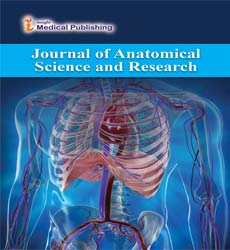Pulmonary Vein: Carrier of Oxygenated Blood
Feins Endo*
Department of Cardiology, University of the Andes, Bogotá, Colombia
- *Corresponding Author:
- Feins Endo
Department of Cardiology,
University of the Andes,
Bogotá,
Colombia
Tel: 04367881598
E-mail: eine@gmail.com
Received Date: October 29, 2021; Accepted Date: November 12, 2021; Published Date: November 19, 2021
Citation: Endo F (2021) Pulmonary Vein: Carrier of Oxygenated Blood. J Anat Sci Res Vol.4 No.5:3.
Description
The pulmonary veins conduit oxygenated blood from the lungs to the left atrium. A small amount of blood is also exhausted from the lungs by the bronchial veins.
There are typically four pulmonary veins, two exhausting each lung:
• right superior: drains the right upper and middle lobes
• right inferior: drains the right lower lobe
• left superior: drains the left upper lobe
• left inferior: drains the left lower lobe
The four pulmonary veins play a vital role in the pulmonary circulation by getting oxygenated blood from the lungs and transporting it to the left atrium, where it can then come into the left ventricle to be distributed all over the body. The pulmonary vein is exceptional in that it is the only vein that carries oxygenated blood.
Until delivery, fetal blood flow bypasses these vessels, which exposed at birth upon exposure to oxygen. There are some anatomic differences that may arise as well as several congenital circumstances (birth defects) involving these veins that are found in some babies. Medical circumstances may arise in adults as well such as pulmonary venous hypertension.
Development
Before birth, the fetus receives oxygen and nutrients from the placenta so that the blood vessels important to the lungs, including the pulmonary artery and pulmonary vein, are bypassed. It's only at the moment of birth when a baby takes its first breath that blood pass in the pulmonary blood vessels to arrive the lungs.
Structure and function
The pulmonary veins initiate from individual alveoli within the lung as capillary vessels. These capillary structures intersect into larger veins called the inter lobar pulmonary veins. An irregularity in the structure and development of these inter lobar pulmonary veins results in predominantly alveolar capillary dysplasia with misalignment of pulmonary veins.
The substandard pulmonary veins are substandard to the pulmonary arteries and are readily identifiable as the most inferior vessel on each hilum. Both left and right pulmonary tendons are inferior and medial to the inferior pulmonary veins. The four pulmonary veins course medially to the left atria, where they groove into the left atrium through four distinct prologues on the posterior wall. The anatomical association of the junction between the pulmonary veins and the epicardium of the left atrium is dissimilar depending on the person. Anomalous pulmonary venous drainage (APVD) is the drainage of one or more pulmonary veins outer the left atrium. Its recognition is critical due to the strong association with congenital heart disease as well as other cardiac and respiratory abnormalities, which have important implications for patient management. The prevalent application of CT combined with the comparatively non-specific clinical presentation of APVD has ensued in the increased incidental recognition of these abnormalities. Knowledge is hence vital as the imaging specialist is now usually the first person to make such a diagnosis. Moreover, pulmonary veins are an essential site for arrhythmogenic foci and radiofrequency ablation of such sites is used in the treatment of refractory atrial fibrillation. Hence an imaging road map of these veins is decisive before any management can take place.
Clinical significance
The pulmonary veins can be affected by medical circumstances present at birth or acquired later on in life. Due to the pulmonary veins central role in the heart and pulmonary circulation, congenital conditions are often accompanying with other heart defects and acquired conditions are often related to other underlying heart circumstances.
Open Access Journals
- Aquaculture & Veterinary Science
- Chemistry & Chemical Sciences
- Clinical Sciences
- Engineering
- General Science
- Genetics & Molecular Biology
- Health Care & Nursing
- Immunology & Microbiology
- Materials Science
- Mathematics & Physics
- Medical Sciences
- Neurology & Psychiatry
- Oncology & Cancer Science
- Pharmaceutical Sciences
